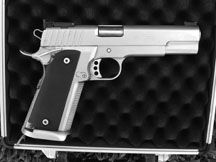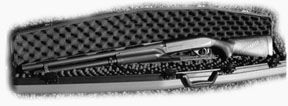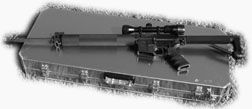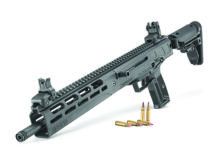Brazil Rejects Countrywide Gun Ban by Two-to-One Margin
A previous Short Shots prediction that Brazil would vote away its citizens gun rights was proven wrong as the country resoundingly chose to keep gun ownership rights alive.
Despite massive publicity by anti-gun groups prior to Brazils nationwide vote in late October, voters refused to strip law-abiding citizens of the ability to defend themselves. Anti-firearms groups from Europe and elsewhere had pushed hard to pass the measure.
Taurus International President Bob Morrison called to set the record straight about the vote: This was a massive defeat for anti-gun groups. They were sure they had this won.
But Morrison pointed out that an alliance of gun-rights proponents won the day because they had the best product to sell – the truth.
Brazilians understood what was at stake, and there was no way people were going to disarm themselves with the criminal element still being armed, he said. People are smart.
He said that trying to take guns away from people who are victimized by roaming gangs of armed hoodlums, and who feel that the law-enforcement establishment is corrupt and inept doesnt make much sense.
John Lott Jr. wrote, The solution to Brazils high murder rate seemed obvious to the Brazilian government, the media, and United Nations: Ban guns. They all went to great efforts to pass an initiative doing just that…, but in the end almost two thirds of Brazils voters rejected the proposal.
Gun control has been a staple of Brazilian life since strict gun-licensing laws went into effect more than 65 years ago. Since 1941 it has been illegal to bring a weapon out of doors without authorization. A 1997 law required firearms-license applicants to undergo psychological testing and show knowledge of firearms. Also, a 1999 law limited each person to two handguns.
Similar bans in Washington, D.C., and Chicago have failed to affect violent crime rates in those cities. In the five years before Washingtons ban in 1976, the murder rate fell from 37 to 27 per 100,000. In the five years after the ban went into effect, the murder rate rose back up to 35. Chicagos murder rate fell from 27 to 22 per 100,000 in the five years before handguns were banned in 1982, and then rose slightly to 23.
Our Take: It seems Brazils citizens understand the value of gun rights more than San Franciscos residents do. See related story further down the page.
———-
Bill Protects Ranges
The Wisconsin State Senate recently passed a bill that would shield the firearms industry, shooting ranges and sporting associations from civil lawsuits stemming from gun violence. The legislation is similar to the recently passed Protection of Lawful Commerce in Arms Act, but includes additional protections for gun clubs, ranges and associations not included in the federal legislation.
Our Take: Its a shame, but we expect Gov. Jim Doyle to veto the bill, and overriding the governors veto will be difficult.
———-
New Rifle Bullet
Winchesters new Supreme Elite XP 3 bullet supposedly has a dual personality. The recently introduced design separates the front of the bullet from the rear lead core using a web of copper jacket material that mechanically locks the bullet together. In addition, a bonded (soldered) rear lead core locks the lead to the jacket.
Effect: The bonding allows the lead to stay with the jacket during impact. The patent pending design yields a two-stage expansion at both the front and in the body of the bullet. In theory, then, the XP 3 bullet can penetrate bone but still expand in lighter, thin-skinned game like deer.
Also, the XP 3 mimics other bullets that now use polymer tips. Such tips weve used in other brands improve downrange performance, offer consistent expansion of the bullets hollow points at low velocities, and prevent damage during loading and unloading.
Also, XP 3 is coated with Winchesters proprietary Lubalox coating, which reduces barrel fouling. The bullet will be offered in .30-06 (150 and 180 grains); 300 WSM (150 and 180 grains); .300 Win. Mag. (150 and 180 grains); 308 Win. (150 grains); 7mm Rem. Mag. (160 grains); 7mm WSM (160 grains); .270 Win (150 grains); and .270 WSM (150 grains).
Our Take: The new Winchester bullet is almost identical to the old, very costly, and superb Jensen J3 bullet (note the name similarity). Ray Ordorica has a few ancient Jensens in .416 cal, and the white-plastic noses (or the glue) have dried up and fallen out. Plastic-tip bullets can have big problems.
———-
NYC Lawsuit Update
A federal judge in New York City has opted to give no decision on a motion to dismiss the citys lawsuit against firearms companies. At the hearing, Eastern District Judge Jack B. Weinstein said he would submit a decision in writing sometime in the near future.
Said Lawrence Keane, NSSF senior vice president and general counsel, Given Judge Weinsteins track record, we fully expect he will deny the motion and try to force the case forward to trial.
Our Take: The Protection of Lawful Commerce in Arms Act was created to protect firearms industry companies from lawsuits just like this one, and Weinstein shouldnt ignore the law.
———-
NRA Files Lawsuit Challenging San Francisco Gun Ban
Even with opposition from San Francisco law enforcement and major media outlets, Proposition H – a measure banning the lawful possession of handguns, and the manufacture and transfer of all firearms and ammunition within San Francisco city limits – passed November 8. The NRA immediately filed a lawsuit challenging the ban.
Said NRA Executive Vice President Wayne LaPierre, This fight is just beginning. Lawful residents of San Francisco are being stripped of their freedom because of an illegal measure that defies common sense. We will fight this outrageous assault on the rights of law-abiding San Franciscans, and I believe that we will prevail.
In response to the passage of this proposition, NRA is leading a coalition of organizations in a lawsuit against this illegal ban in San Francisco. Proposition H, in addition to violating federal guarantees, also violates various California state laws and is therefore preempted.
Our Take: Ultimately, though, the vote didnt mean much. As San Francisco Mayor Gavin Newsom said, the ban clearly will be thrown out [in court]… Its really just a public opinion poll at the end of the day. State law prohibits local jurisdictions from enacting such a ban, and an even weaker law requiring handgun registration that was enacted by the San Francisco County Board of Supervisors in 1982 was thrown out by the California state supreme court.
———-
Return Confiscated Guns, Rep Says
Law-enforcement agencies should return firearms confiscated from hurricane victims, says Louisiana State Rep. Steve Scalise, R-Metairie.
Citing a 36-year-old state law that conflicts with the Louisiana and U.S. constitutions, law officers seized weapons from hurricane victims, particularly in the New Orleans area. Although a court has ordered the return of the weapons, some people havent gotten back their guns, Scalise said Wednesday.
I brought a resolution to at least bring it to peoples attention that this is something we want to state, as a matter of public policy, that we dont agree with that law. We also want to repeal that law, in the next special session or, at the latest, in March.
Our Take: Recalling televised images of people looting after Hurricane Katrina, other legislators said they want to ensure police have the authority needed to maintain control, which might include confiscations. Many agree with Scalise on the need to change the law but are concerned about possibly hampering law enforcement if and when similar situations arise.
———-
New National-Class LE/Competition Shooting Range Set for May Launch
In November, plans were unveiled for the United States Shooting Academy, a $1.5 million project on 90 acres outside Tulsa, which was billed as the nations largest law-enforcement training and competition shooting facility. Opening is set for May 2006.
Tom Fee, president of Fee Oil and Gas Ltd. and owner of the new business said, There are other training and competition ranges out there, but nothing is going to touch this one.
For too long, competitors in the shooting sports have not been perceived on the same level as say golf and tennis players. I am going to change that. By showcasing the shooting sports in the same way that other professional sports do, we will elevate them to a more nationally acceptable level.
Much of facility will be designed specifically to accommodate a range of law enforcement agencies, from police and sheriffs departments to federal law enforcement agencies and military branches.
Training areas will include 30 pistol bays, a police area, rifle range, shotgun range, hostage rescue area, an urban area with simulated houses and streets, a hand-to-hand combat section and two helipads for helicopter instruction.
He said major matches will take place between March and November. Smaller matches will be held every month.
The facility will also include a main lodge, 10 guest houses capable of accommodating a total of 100 people, and an armory. Also, Fee said staff members will teach classes to private citizens, but the academy will not operate as a recreational shooting range or gun club.
Our Take: Preliminary plans for the site seem tailored for LE use, and we applaud that. More broadly, by running competitions as a business, we think that having paid employees working the matches alongside volunteers could lead to faster, better-run national competitions.
———-
Three Guns We Bought – And Used
At Gun Tests, we do spend most of our time shooting guns that other people may wish to buy. But we occasionally get to shoot our own guns, as Contributing Editor Roger Eckstine did recently at what was formerly the United States Practical Shooting Association 3-Gun National Championship, but which has been renamed the USPSA Multi-Gun Nationals. The event took place at the Desert Sportsmans Rifle and Pistol Club outside Las Vegas, Oct. 13-16, 2005.
The Multi-Gun Championship pits competitors equipped with rifles, pistols, and shotguns against 12 complex shooting stages. Scoring for all events is based on speed and accuracy (points earned per second).
Eckstine said, As expected, I was not much of a threat to the big dogs, but I did get my hits, even on the 325-yard steel targets with my Bushmaster. I also hummed through the shotgun stage that featured 10-inch steel plates at 60 yards offhand, one shot one kill with just a bead sight.
The result was no trophy, but some good bragging rights and a $500 award from Bill Davisons TacPro training facility.

Eckstines guns of choice included a .40 S&W Limited Division pistol built on the new Springfield Armory high cap frame, with gunsmithing by Ross Carter of Harrison, Arkansas, (870) 741-2265. It featured a Schueman bull barrel, Cylinder and Slide trigger group, Dawson Precision front sight, BoMar rear sight and Carters canyon-like magazine well surrounded by a lot of sharp checkering. The slide has been lightened considerably, and the hard chrome finish is by Metalloy of Berryville, Arkansas.
Every stage was either shotgun, rifle, pistol or a combination thereof, requiring a redesign of my rig. Wearing a Blackhawk nylon belt with soft Velcro inner surface matched to a rough Velcro belt looped into my pants made the on/offs easy, and together the two belts offered reliable support. I used a Hoffner Quad packer to carry my four pistol mags, California Competition Works belt carriers for spare shotgun ammo, and AR mag pouches by BladeTech. His pistol rode in a Safariland 561 paddle holster.

Eckstines shotgun was an out-of-the box Benelli M2 with 24-inch barrel and the recoil-absorbing Comfort Tech stock. He said his modifications were limited to bolt-on upgrades from Brownells, such as the $95 SRM magazine extension braced by the $45 Clark Custom Guns barrel clamp. Capacity was 8+1.
His .223 AR-15 was a Bushmaster V Match rifle specced-out by Product Coordination Editor Ben Brooks with optional parts installed at the Bushmaster factory. These included the skeleton stock, Y-COMP muzzle brake, Hogue grip and collapsible front sight. The bolt-on A2 rear sight was replaced by a Bushnell Banner 1-4X turkey scope. Eckstine chose an aluminum breakdown case, (XF-226578, $160) from Cabelas for transport.

He said, Going into the match my rifle preparation consisted of mounting the scope on the AR and sighting it in the day before the match. In my single day of shotgun practice, I found out that Remington STS ammunition reloaded the smoothest, and I had better wear a glove if I was going to use the border-switch method of reloading the shotgun. The barrel was mighty hot when holding it upside down and pumping in fresh rounds.
Its a lot of work to shoot a three-gun format, Eckstine said, but I would have to say that it was three times the fun.


























